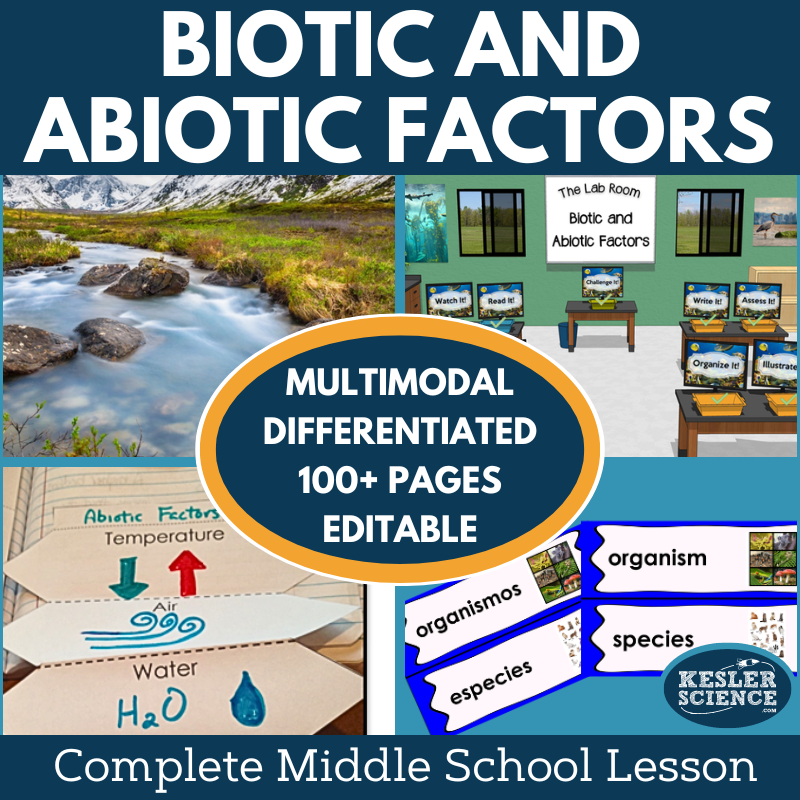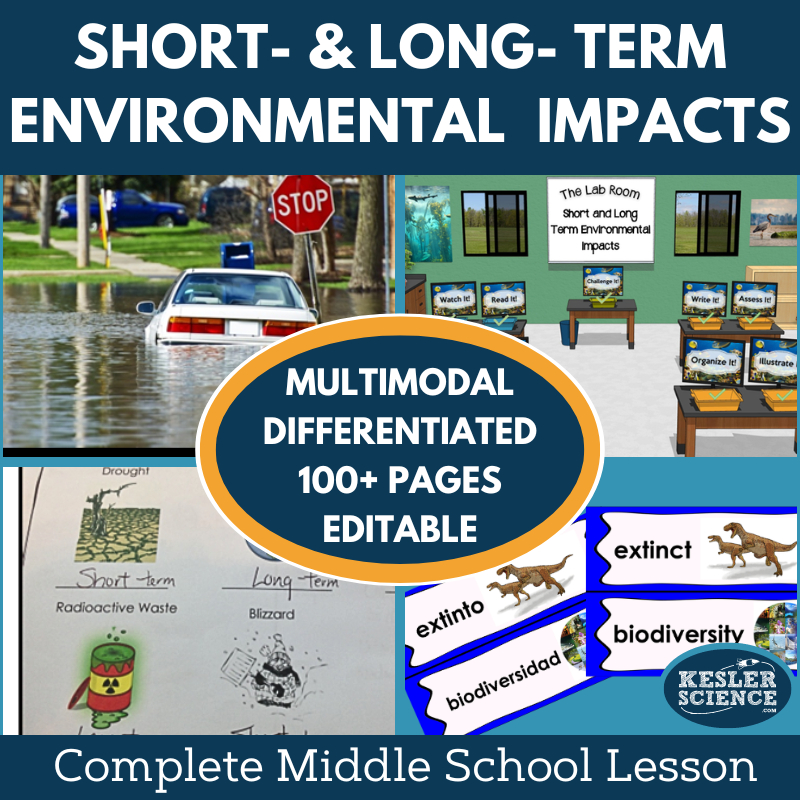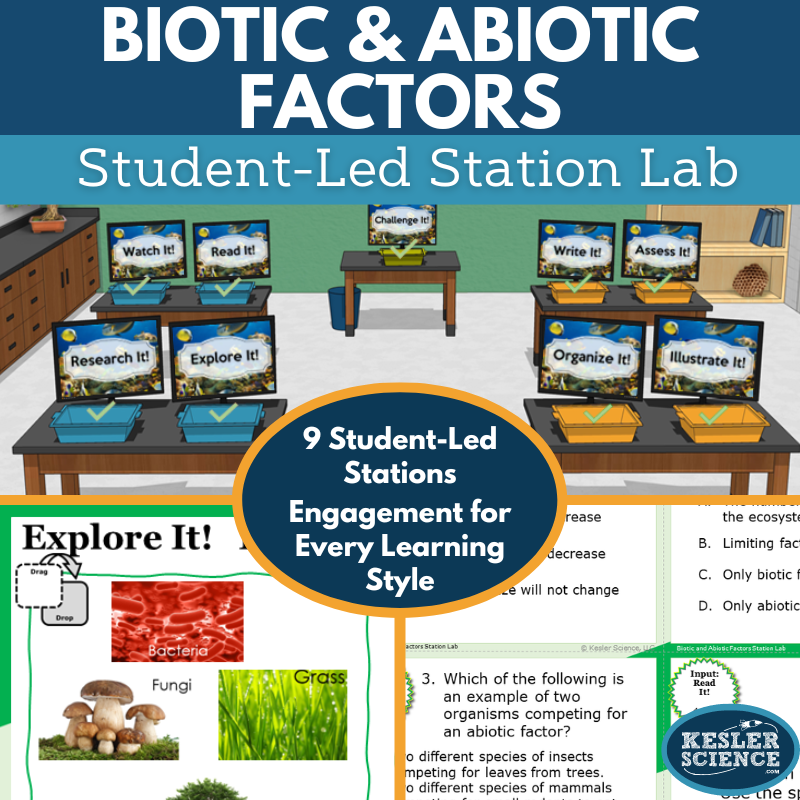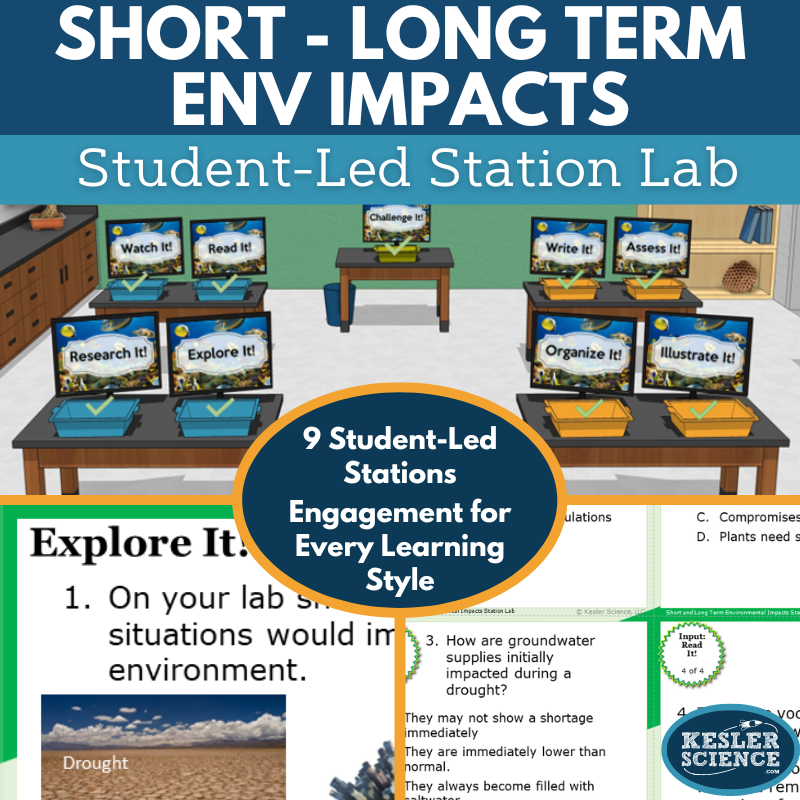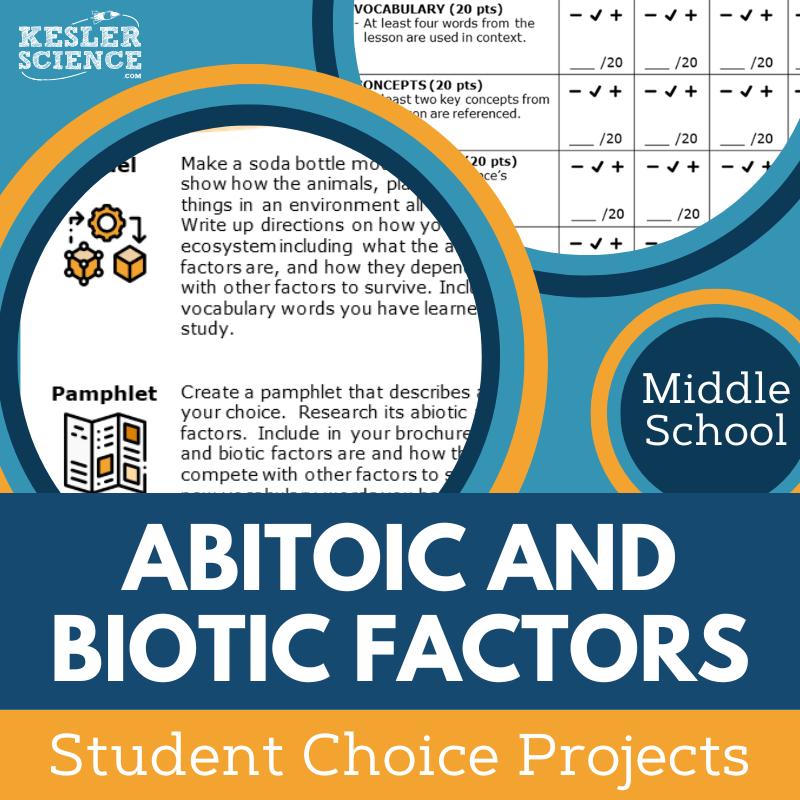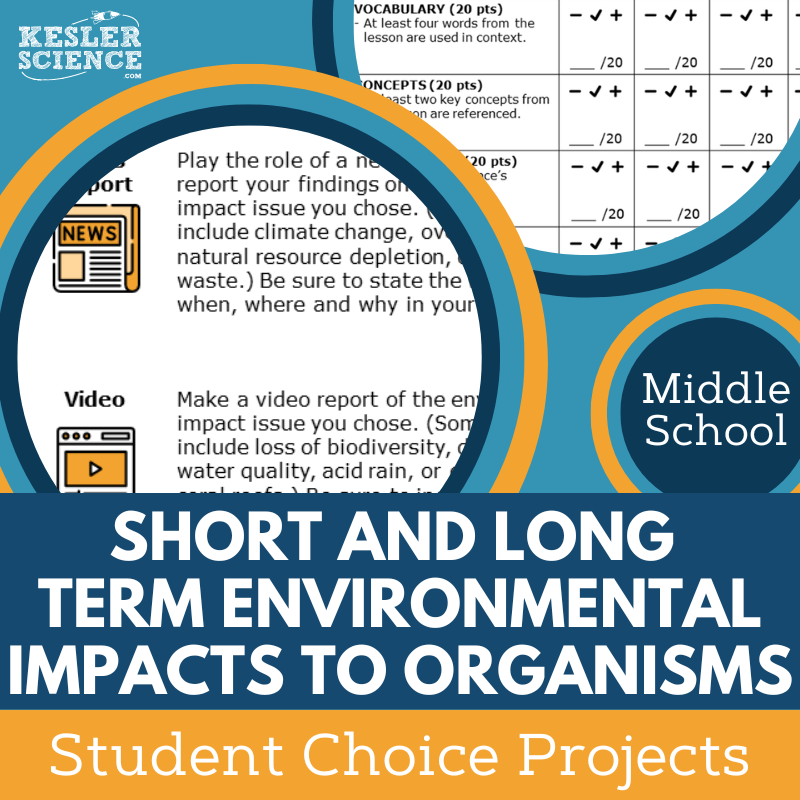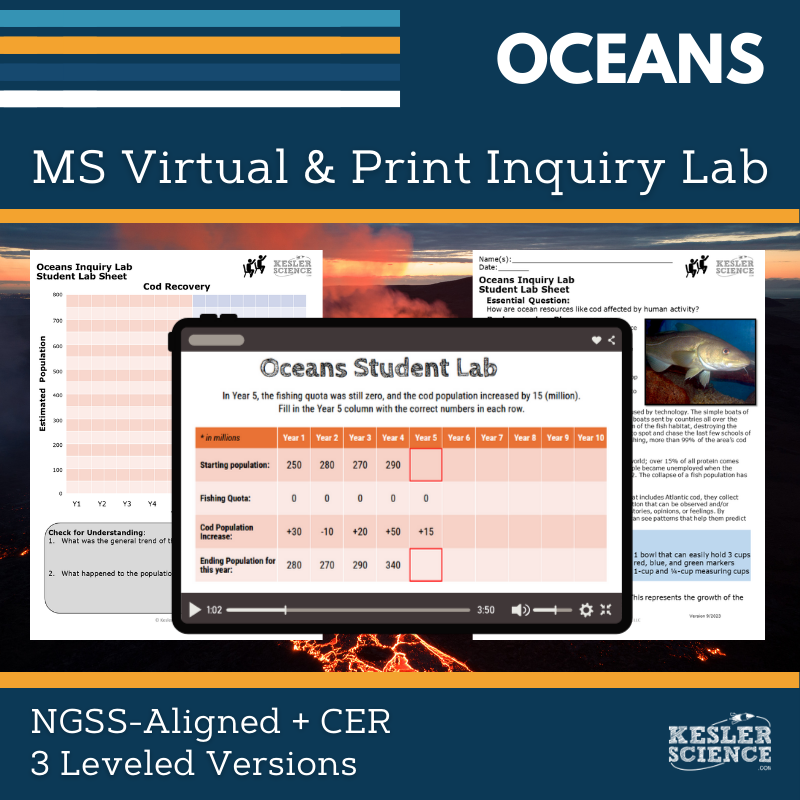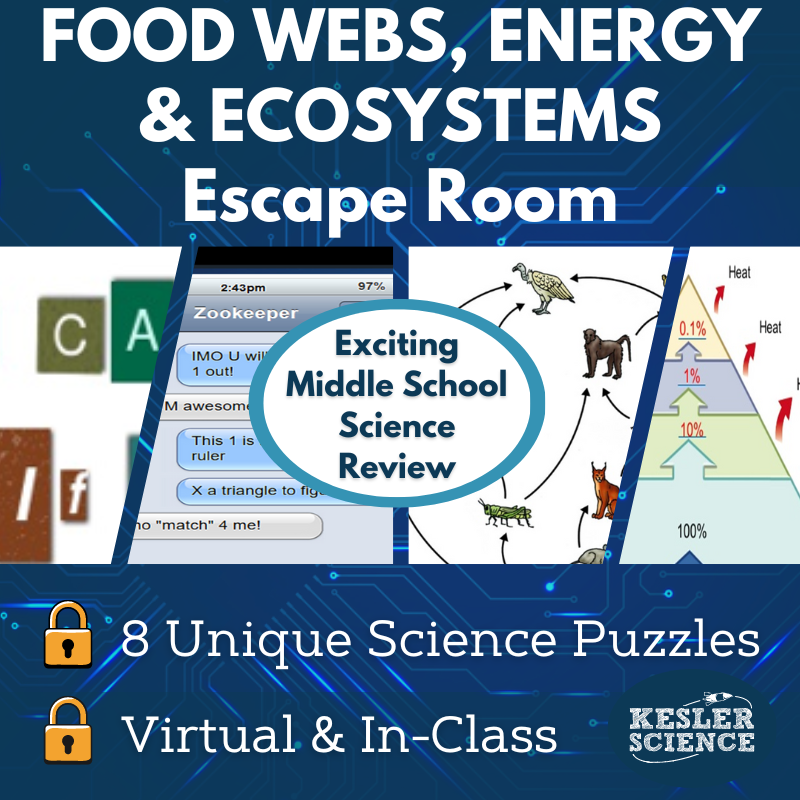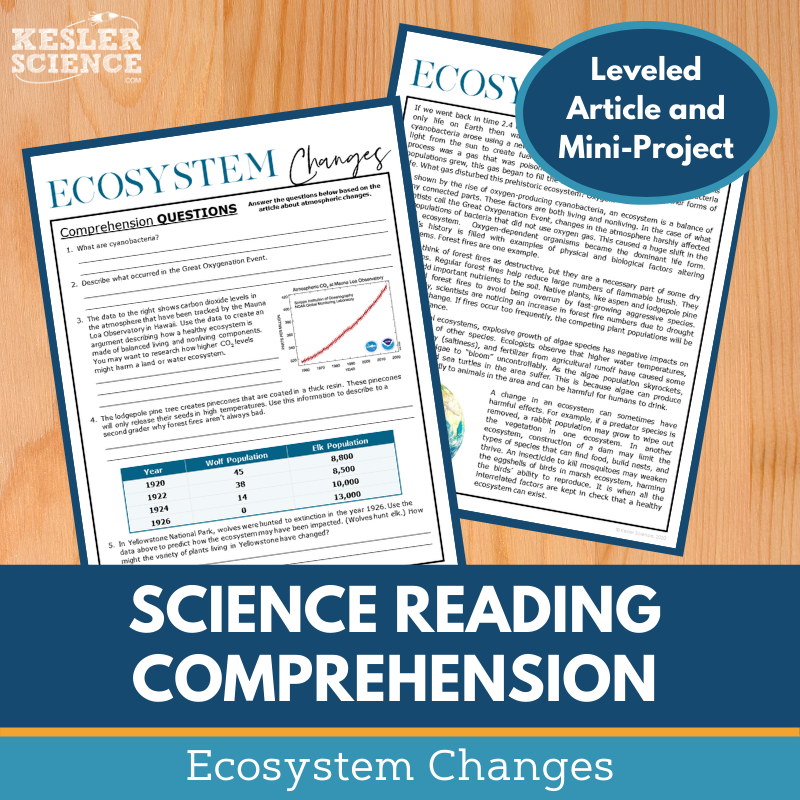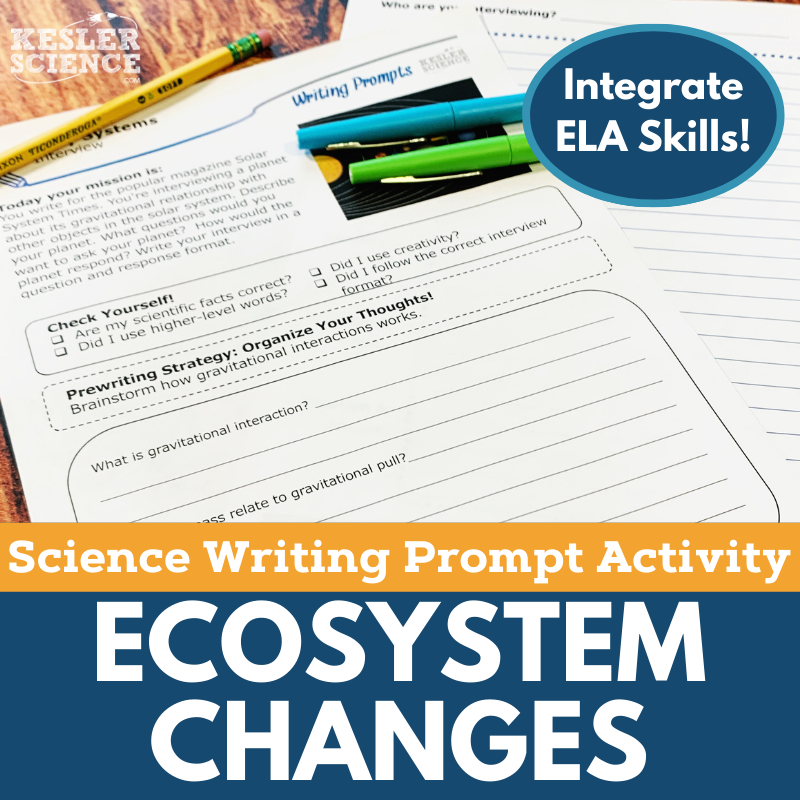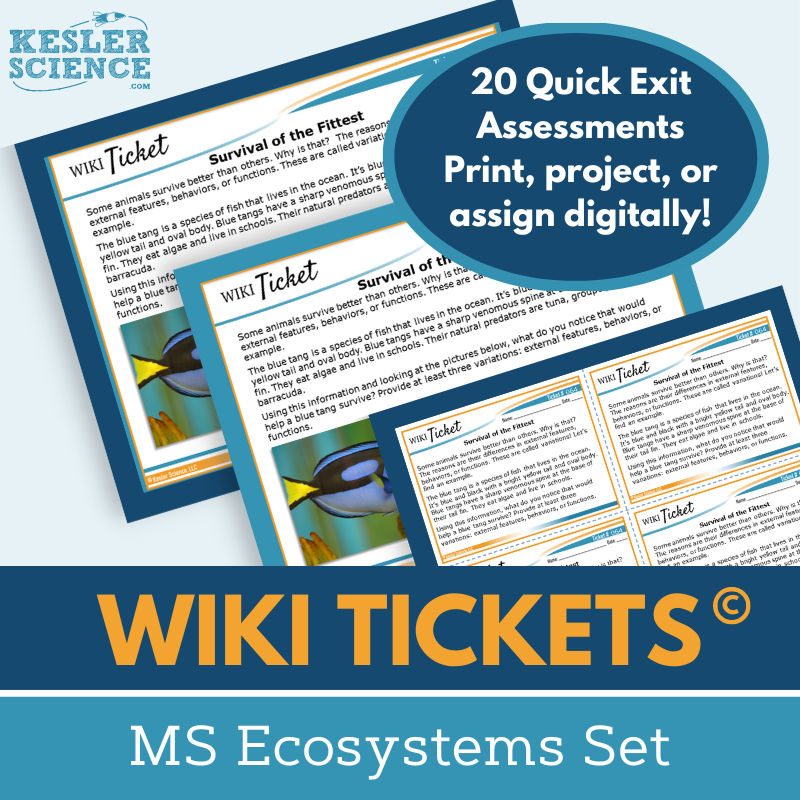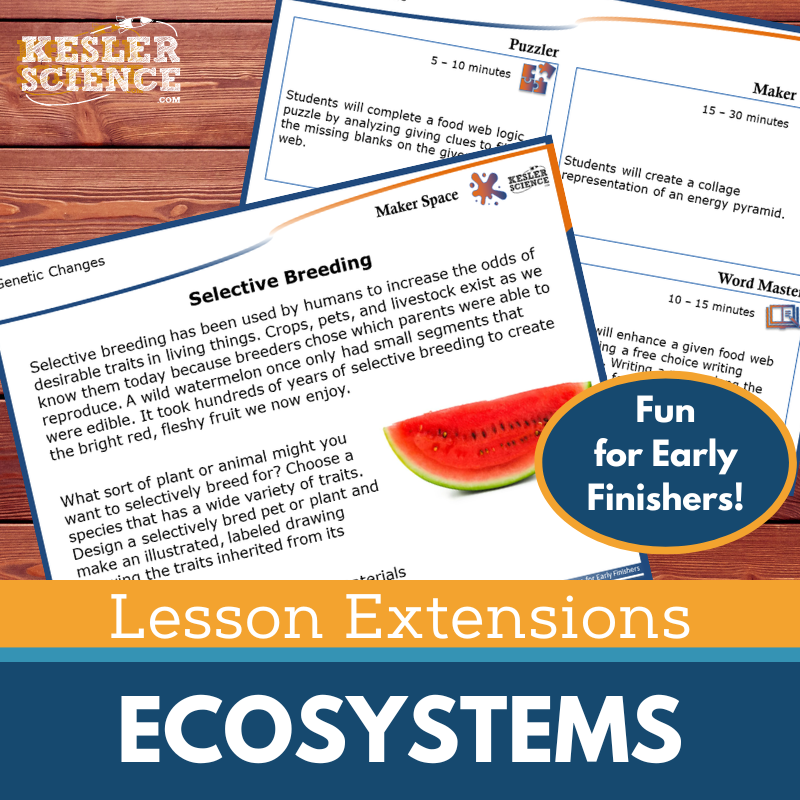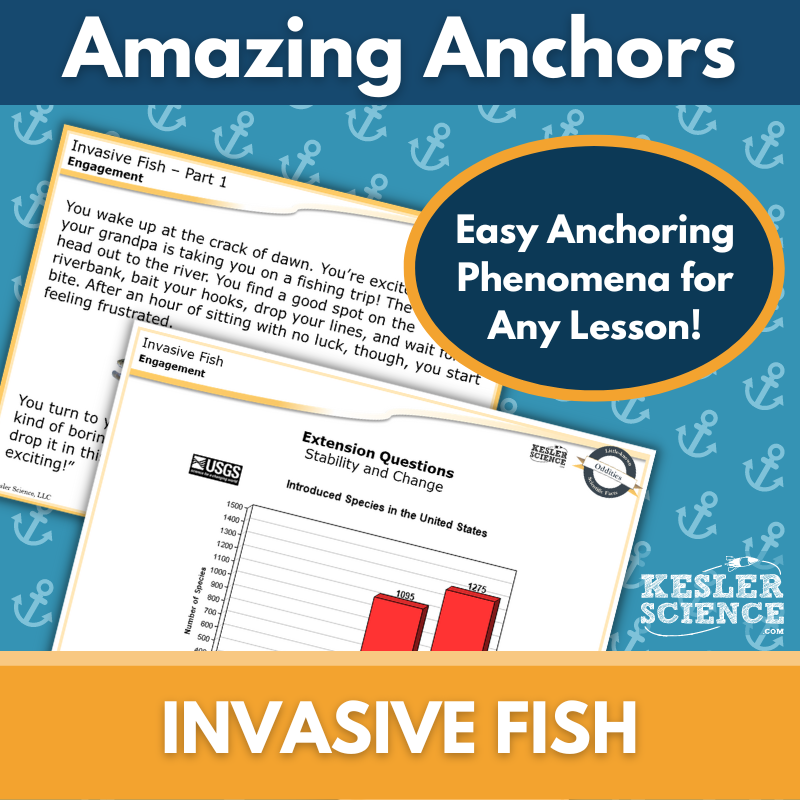Effects of Ecosystem Change Activities for Middle School Science
The Kesler Science Biotic and Abiotic Factors and Short- and Long-Term Environmental Impacts 5E Lessons engage middle school students in exploring ecosystem interactions and environmental changes through the research-based 5E model. The resources below will give students a comprehensive understanding of effects of ecosystem change. All of the following materials are also included in the Kesler Science Membership.
The Kesler Science Biotic and Abiotic Factors 5E Lesson provides an engaging and comprehensive middle school science unit aligned with NGSS standards. It uses the research-based 5E model—Engagement, Exploration, Explanation, Elaboration, and Evaluation—to explore how organisms depend on and compete for biotic and abiotic factors in ecosystems.
This student-led lesson includes differentiated and multimodal materials such as editable PowerPoints, interactive notebooks, worksheets, choice projects, and assessments to meet diverse learner needs. In the Exploration phase, students engage in a differentiated station lab with hands-on experiments, readings, research, videos, and interactive tasks to deepen their understanding. The lesson also supports bilingual learners with resources available in both English and Spanish.
Flexible formatting allows for easy adaptation for classroom or virtual use, requiring minimal preparation. Additionally, students extend their learning through choice projects, while assessments aligned with STAAR 2.0 standards effectively evaluate student mastery.
The Kesler Science Biotic and Abiotic Factors 5E Lesson provides an engaging and comprehensive middle school science unit aligned with NGSS standards. It uses the research-based 5E model—Engagement, Exploration, Explanation, Elaboration, and Evaluation—to explore how organisms depend on and compete for biotic and abiotic factors in ecosystems.
This student-led lesson includes differentiated and multimodal materials such as editable PowerPoints, interactive notebooks, worksheets, choice projects, and assessments to meet diverse learner needs. In the Exploration phase, students engage in a differentiated station lab with hands-on experiments, readings, research, videos, and interactive tasks to deepen their understanding. The lesson also supports bilingual learners with resources available in both English and Spanish.
Flexible formatting allows for easy adaptation for classroom or virtual use, requiring minimal preparation. Additionally, students extend their learning through choice projects, while assessments aligned with STAAR 2.0 standards effectively evaluate student mastery.
The Kesler Science Short- & Long-Term Environmental Impacts 5E Lesson is a comprehensive, student-led unit designed for middle school. It includes editable presentations, worksheets, assessments, and student-choice projects for differentiated, multimodal learning with minimal prep.
Following the 5E Model, the lesson begins with engagement through vocabulary word walls and teacher-led discussions. Exploration features a differentiated station lab with nine hands-on, reading, research, and multimedia stations. Explanation includes editable PowerPoints, interactive notebooks, and note-taking templates in English and Spanish. Students extend their learning in the elaboration phase through choice projects, while evaluation includes STAAR 2.0-aligned assessments, review worksheets, and discussion questions.
With printable and digital formats, Spanish translations, and maximum flexibility, this resource supports both in-class and virtual learning.
The Kesler Science Short- & Long-Term Environmental Impacts 5E Lesson is a comprehensive, student-led unit designed for middle school. It includes editable presentations, worksheets, assessments, and student-choice projects for differentiated, multimodal learning with minimal prep.
Following the 5E Model, the lesson begins with engagement through vocabulary word walls and teacher-led discussions. Exploration features a differentiated station lab with nine hands-on, reading, research, and multimedia stations. Explanation includes editable PowerPoints, interactive notebooks, and note-taking templates in English and Spanish. Students extend their learning in the elaboration phase through choice projects, while evaluation includes STAAR 2.0-aligned assessments, review worksheets, and discussion questions.
With printable and digital formats, Spanish translations, and maximum flexibility, this resource supports both in-class and virtual learning.
Engage your middle school students with this modular, student-led station lab aligned with NGSS standards, exploring biotic and abiotic factors in ecosystems. Students independently identify, compare, and apply concepts through nine differentiated stations featuring multimodal activities such as hands-on tasks, interactive research, reading passages in English and Spanish, and videos.
Input stations like Explore It!, Research It!, Read It!, and Watch It! introduce foundational concepts through interactive tasks, digital manipulation of images and text, and guided readings. Output stations, including Organize It!, Illustrate It!, Write It!, and Assess It!, allow students to demonstrate understanding through models, writing, manipulatives, and assessments. An additional Challenge It! station provides extension activities such as crosswords, games, and mini-projects for early finishers.
Designed for both classroom and virtual settings, this student-centered resource promotes personalized learning, active engagement, and critical thinking.
Engage your middle school students with this modular, student-led station lab aligned with NGSS standards, exploring biotic and abiotic factors in ecosystems. Students independently identify, compare, and apply concepts through nine differentiated stations featuring multimodal activities such as hands-on tasks, interactive research, reading passages in English and Spanish, and videos.
Input stations like Explore It!, Research It!, Read It!, and Watch It! introduce foundational concepts through interactive tasks, digital manipulation of images and text, and guided readings. Output stations, including Organize It!, Illustrate It!, Write It!, and Assess It!, allow students to demonstrate understanding through models, writing, manipulatives, and assessments. An additional Challenge It! station provides extension activities such as crosswords, games, and mini-projects for early finishers.
Designed for both classroom and virtual settings, this student-centered resource promotes personalized learning, active engagement, and critical thinking.
Engage your middle school students with this modular, student-led station lab on short- and long-term environmental impacts. Designed for in-class or virtual learning, this hands-on lesson allows students to explore key concepts through nine interactive stations featuring readings, research, videos, and hands-on activities.
Students will investigate environmental impacts through a mix of input and output stations, where they read passages, watch videos, conduct research, and complete hands-on demonstrations. They will then demonstrate their learning by organizing information, illustrating models, writing responses, and answering assessment questions. A bonus challenge station provides extension activities for early finishers, while differentiated reading passages in English and Spanish support diverse learners.
This low-prep, high-engagement resource fosters critical thinking and independent learning, with all necessary materials provided for seamless classroom integration.
Engage your middle school students with this modular, student-led station lab on short- and long-term environmental impacts. Designed for in-class or virtual learning, this hands-on lesson allows students to explore key concepts through nine interactive stations featuring readings, research, videos, and hands-on activities.
Students will investigate environmental impacts through a mix of input and output stations, where they read passages, watch videos, conduct research, and complete hands-on demonstrations. They will then demonstrate their learning by organizing information, illustrating models, writing responses, and answering assessment questions. A bonus challenge station provides extension activities for early finishers, while differentiated reading passages in English and Spanish support diverse learners.
This low-prep, high-engagement resource fosters critical thinking and independent learning, with all necessary materials provided for seamless classroom integration.
This Biotic and Abiotic Factors Student Choice Projects lesson aligns with NGSS science standards, enabling middle school students to select a project matching their preferred style. A project page offers nine student-led options plus a “design your own” choice, supported by an editable rubric for teacher, peer, or self-assessment.
The projects are flexible, dynamic, and multimodal, allowing students creative ways to demonstrate understanding. Two versions of the project page provide differentiation—one includes modified options for remediation, while challenge opportunities are available through combinations of projects. The rubric assesses vocabulary, concepts, presentation, clarity, and accuracy, and teachers can adjust it to their grading needs.
Projects require common classroom materials such as paper, markers, and scissors, and many can be completed digitally. Some crafting supplies may be helpful for building models.
This Biotic and Abiotic Factors Student Choice Projects lesson aligns with NGSS science standards, enabling middle school students to select a project matching their preferred style. A project page offers nine student-led options plus a “design your own” choice, supported by an editable rubric for teacher, peer, or self-assessment.
The projects are flexible, dynamic, and multimodal, allowing students creative ways to demonstrate understanding. Two versions of the project page provide differentiation—one includes modified options for remediation, while challenge opportunities are available through combinations of projects. The rubric assesses vocabulary, concepts, presentation, clarity, and accuracy, and teachers can adjust it to their grading needs.
Projects require common classroom materials such as paper, markers, and scissors, and many can be completed digitally. Some crafting supplies may be helpful for building models.
The Short and Long Term Environmental Impacts Student Choice Projects align with NGSS standards, allowing middle school students to select a project that matches their preferred output style. A project page outlines nine student-led options, including a “design your own” project, with an editable rubric for teacher, peer, or self-assessment.
These flexible, multimodal projects provide creative ways for students to demonstrate their understanding. Two versions of the project page support differentiation, with modified options for students needing remediation and challenge opportunities for advanced learners. Teachers can adjust the rubric to fit grading needs and assign multiple projects if desired.
The projects use standard classroom supplies like paper, markers, and scissors, with many options available for digital completion. Some crafting materials may be helpful for model-building.
The Short and Long Term Environmental Impacts Student Choice Projects align with NGSS standards, allowing middle school students to select a project that matches their preferred output style. A project page outlines nine student-led options, including a “design your own” project, with an editable rubric for teacher, peer, or self-assessment.
These flexible, multimodal projects provide creative ways for students to demonstrate their understanding. Two versions of the project page support differentiation, with modified options for students needing remediation and challenge opportunities for advanced learners. Teachers can adjust the rubric to fit grading needs and assign multiple projects if desired.
The projects use standard classroom supplies like paper, markers, and scissors, with many options available for digital completion. Some crafting materials may be helpful for model-building.
The Oceans Inquiry Lab aligns with NGSS MS LS2-4, guiding students to construct arguments based on empirical evidence about how ecosystem changes affect populations. This lab explores the collapse of the North Atlantic cod population, allowing students to model the effects of a fishing quota and estimate a population using beans.
This resource includes both print and digital formats. The hands-on print version requires students to conduct an experiment using cod cards, beans, and measuring tools, while the digital version features an interactive PowerPoint compatible with Google Slides and LMS platforms. A built-in game reinforces mark and recapture methods and conservation strategies.
Three differentiated levels—Dependent, Modified, and Independent—ensure accessibility for all learners, providing structured guidance or student-led inquiry as needed. The lab also includes comprehension questions, Claim-Evidence-Reasoning (C.E.R.) prompts, reflection sections, and teacher resources such as answer keys and editable materials.
The Oceans Inquiry Lab aligns with NGSS MS LS2-4, guiding students to construct arguments based on empirical evidence about how ecosystem changes affect populations. This lab explores the collapse of the North Atlantic cod population, allowing students to model the effects of a fishing quota and estimate a population using beans.
This resource includes both print and digital formats. The hands-on print version requires students to conduct an experiment using cod cards, beans, and measuring tools, while the digital version features an interactive PowerPoint compatible with Google Slides and LMS platforms. A built-in game reinforces mark and recapture methods and conservation strategies.
Three differentiated levels—Dependent, Modified, and Independent—ensure accessibility for all learners, providing structured guidance or student-led inquiry as needed. The lab also includes comprehension questions, Claim-Evidence-Reasoning (C.E.R.) prompts, reflection sections, and teacher resources such as answer keys and editable materials.
The Food Webs, Energy, and Ecosystem Escape Room is an interactive experience that challenges students to demonstrate their understanding of food webs, food chains, and energy transfer within ecosystems in an engaging way.
Teachers have full control over the eight independent puzzles, allowing customization based on class time and student needs. The escape room can be conducted using manila envelopes and printed materials or with a more immersive setup involving locks and a storage box. A digital version is available for online learning through PowerPoint or Google Slides, and a printable version can be assigned for at-home use.
This resource includes teacher directions, a detailed answer key, digital and printable student versions, an editable teacher version, a Google Forms answer sheet, a video challenge, and eight unique puzzles with printable props. Additional materials such as reward templates, signs for photos, and over 50 prize ideas help create an exciting and memorable learning experience.
The Food Webs, Energy, and Ecosystem Escape Room is an interactive experience that challenges students to demonstrate their understanding of food webs, food chains, and energy transfer within ecosystems in an engaging way.
Teachers have full control over the eight independent puzzles, allowing customization based on class time and student needs. The escape room can be conducted using manila envelopes and printed materials or with a more immersive setup involving locks and a storage box. A digital version is available for online learning through PowerPoint or Google Slides, and a printable version can be assigned for at-home use.
This resource includes teacher directions, a detailed answer key, digital and printable student versions, an editable teacher version, a Google Forms answer sheet, a video challenge, and eight unique puzzles with printable props. Additional materials such as reward templates, signs for photos, and over 50 prize ideas help create an exciting and memorable learning experience.
This Ecosystem Changes Science Reading Comprehension Lesson helps students explore ecosystem changes through a nonfiction article. Designed for middle school, the leveled passage supports science literacy and reading comprehension.
The resource includes two Lexile-leveled articles (1100-1300), five to seven comprehension questions, a hands-on mini-project, and a Cornell notes template. Engaging graphics are included and can be printed in grayscale.
Ideal for sub plans, extra credit, ISS, or whole-class instruction, this resource fosters critical thinking, classroom discussions, and textual analysis. It is compatible with Google Classroom, MS Teams, Schoology, and Canvas, allowing students to complete assignments in a virtual or in-person setting.
This Ecosystem Changes Science Reading Comprehension Lesson helps students explore ecosystem changes through a nonfiction article. Designed for middle school, the leveled passage supports science literacy and reading comprehension.
The resource includes two Lexile-leveled articles (1100-1300), five to seven comprehension questions, a hands-on mini-project, and a Cornell notes template. Engaging graphics are included and can be printed in grayscale.
Ideal for sub plans, extra credit, ISS, or whole-class instruction, this resource fosters critical thinking, classroom discussions, and textual analysis. It is compatible with Google Classroom, MS Teams, Schoology, and Canvas, allowing students to complete assignments in a virtual or in-person setting.
The Ecosystem Changes Science Writing Prompt Activity engages middle school students in a creative news event report exercise to reinforce their understanding of life science. Aligned with MS-LS2-4, this activity challenges students to construct arguments using empirical evidence to show how changes in physical or biological components of an ecosystem affect populations. Designed for both in-person and virtual learning, it supports science reasoning, exploration, and writing skills.
This resource includes teacher directions with an answer guide, project ideas, and rubrics. It features projection and print handouts, full-sized and half-sheet student materials, and a digital PowerPoint version adaptable for Google Slides. The activity is ideal for cross-curricular learning, pre-test assessment, student choice projects, early finisher tasks, extra credit, make-up work, TELPAS samples, and differentiation. Prompts assume prior knowledge or access to research materials and can be displayed on bulletin boards or compiled into student anthologies.
The Ecosystem Changes Science Writing Prompt Activity engages middle school students in a creative news event report exercise to reinforce their understanding of life science. Aligned with MS-LS2-4, this activity challenges students to construct arguments using empirical evidence to show how changes in physical or biological components of an ecosystem affect populations. Designed for both in-person and virtual learning, it supports science reasoning, exploration, and writing skills.
This resource includes teacher directions with an answer guide, project ideas, and rubrics. It features projection and print handouts, full-sized and half-sheet student materials, and a digital PowerPoint version adaptable for Google Slides. The activity is ideal for cross-curricular learning, pre-test assessment, student choice projects, early finisher tasks, extra credit, make-up work, TELPAS samples, and differentiation. Prompts assume prior knowledge or access to research materials and can be displayed on bulletin boards or compiled into student anthologies.
These WIKI Tickets© Formative Assessments offer engaging, flexible ways to check student understanding of Ecosystems topics in 6th-8th grade science. The set includes 20 topics, each provided in five different formats: a full-screen projection version, three printable handouts (full-page, half-page, quarter-page), and an interactive digital version compatible with PowerPoint and Google Slides.
Aligned with middle school NGSS and TEKS standards, these versatile resources can serve as exit tickets, bellringers, or quick formative checks in both in-person and virtual classrooms. Topics include biodiversity, biotic and abiotic factors, taxonomy, ecological succession, food webs, human impacts, natural selection, photosynthesis, and environmental changes. A table of contents detailing standards alignment is included to help educators effectively track student progress.
These WIKI Tickets© Formative Assessments offer engaging, flexible ways to check student understanding of Ecosystems topics in 6th-8th grade science. The set includes 20 topics, each provided in five different formats: a full-screen projection version, three printable handouts (full-page, half-page, quarter-page), and an interactive digital version compatible with PowerPoint and Google Slides.
Aligned with middle school NGSS and TEKS standards, these versatile resources can serve as exit tickets, bellringers, or quick formative checks in both in-person and virtual classrooms. Topics include biodiversity, biotic and abiotic factors, taxonomy, ecological succession, food webs, human impacts, natural selection, photosynthesis, and environmental changes. A table of contents detailing standards alignment is included to help educators effectively track student progress.
Lesson Extensions offer engaging, student-choice activities specifically designed to challenge early finishers and deepen their understanding of ecosystems aligned with NGSS and TEKS standards. These extensions provide rigorous yet enjoyable learning opportunities ideal for lesson wrap-ups, downtime during testing, or preventing distractions by keeping students actively engaged.
Each extension includes four interactive components: Puzzler for developing problem-solving skills, Maker Space for hands-on STEAM activities, Tech Connection for digital media demonstrations, and Word Master for creative writing exercises related to science. The resources come with teacher directions, answer keys, and both digital projection and print versions (full- and half-sheet sizes) for classroom flexibility.
This bundle covers diverse ecosystem topics, including biodiversity, biomes, biotic and abiotic factors, ecological succession, food webs, human impact, photosynthesis, resource availability, and many more, supporting high-level enrichment and independent learning.
Lesson Extensions offer engaging, student-choice activities specifically designed to challenge early finishers and deepen their understanding of ecosystems aligned with NGSS and TEKS standards. These extensions provide rigorous yet enjoyable learning opportunities ideal for lesson wrap-ups, downtime during testing, or preventing distractions by keeping students actively engaged.
Each extension includes four interactive components: Puzzler for developing problem-solving skills, Maker Space for hands-on STEAM activities, Tech Connection for digital media demonstrations, and Word Master for creative writing exercises related to science. The resources come with teacher directions, answer keys, and both digital projection and print versions (full- and half-sheet sizes) for classroom flexibility.
This bundle covers diverse ecosystem topics, including biodiversity, biomes, biotic and abiotic factors, ecological succession, food webs, human impact, photosynthesis, resource availability, and many more, supporting high-level enrichment and independent learning.
This Amazing Anchors Phenomenon Lesson introduces invasive species through a real-world fishing trip scenario. The resource includes an introductory reading with comprehension and extension questions to engage students, followed by an explanatory reading that breaks down the science of invasive species with additional reinforcement questions.
Designed to support NGSS standard MS LS2-4 and TEKS science standards, this no-prep resource includes teacher directions with answer keys, projection slides, a digital version for LMS platforms, and printable full- and half-sheet handouts. The lesson is available in both differentiated and modified formats, offering sentence starters and language support for students who need assistance. Ideal for bookending a lesson, these readings fit seamlessly into the Engagement and Elaborate segments of a 5E lesson and are available in print and digital formats for flexible classroom use.
This Amazing Anchors Phenomenon Lesson introduces invasive species through a real-world fishing trip scenario. The resource includes an introductory reading with comprehension and extension questions to engage students, followed by an explanatory reading that breaks down the science of invasive species with additional reinforcement questions.
Designed to support NGSS standard MS LS2-4 and TEKS science standards, this no-prep resource includes teacher directions with answer keys, projection slides, a digital version for LMS platforms, and printable full- and half-sheet handouts. The lesson is available in both differentiated and modified formats, offering sentence starters and language support for students who need assistance. Ideal for bookending a lesson, these readings fit seamlessly into the Engagement and Elaborate segments of a 5E lesson and are available in print and digital formats for flexible classroom use.
Year-Round Resources
These year-round activities will increase your students' understanding of many middle school science topics. All of these activities are also included in the Kesler Science Membership.
Visual Data & Graphing
You're not alone if your students struggle with understanding graphs, charts, and tables. It's a skill that takes an enormous amount of practice. This resource will help students build a strong foundation in analyzing data and creating their own data visualizations.
Bell Ringers and Warm-Ups
These middle school science bell ringers are an excellent way to engage your students as soon as they walk into your classroom. This comprehensive FULL YEAR resource includes everything you need to start off each science class with an interesting warm-up activity.
Review Board Games
Each game board has been carefully designed to keep students engaged. There are 10 different action spaces on each board and dozens of question cards. All of the actions are related to science concepts and keep the students motivated throughout the game.
Each game is ready to play. Simply print out the board and the cards and let the students enjoy reviewing nine different units.
Essential Questions and Standards
Below are the essential questions and standards associated with the lessons and activities included in the effects of ecosystem change unit. This topic is only one of more than 100 middle school science topics included in the Kesler Science Membership.
-
What are the biotic and abiotic parts of an ecosystem?
-
How do organisms and populations in an ecosystem depend on and compete for biotic and abiotic factors?
-
How do environmental changes (both short- and long-term) affect organisms and traits in subsequent populations?
-
NGSS - MS-LS2-4 Effects of Ecosystem Change
Kesler Science Membership
Imagine never having to search for another middle school science lesson again. The membership gives you access to ALL of the Kesler Science products in one place (Yes, including everything above).
Say goodbye to long hours of lesson prep.

